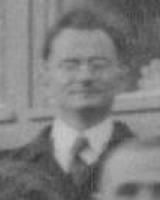Egon Ullrich
Egon Ullrich (born November 1, 1902 in Vienna ; † May 30, 1957 in Gießen ) was an Austrian mathematician who dealt with function theory.
Life
Egon Ullrich grew up in Graz and studied mathematics, physics and folklore at the University of Graz (as well as one semester in Berlin in 1923). He received his doctorate in 1925 in Graz under Anton Rella (on the correspondence of two classes of limitation procedures) and was then a high school teacher there. In 1926 he went to Ludwig Bieberbach in Berlin and on his recommendation in 1927 to Ernst Lindelöf and Rolf Nevanlinna in Helsinki . Later he kept in touch with Finnish mathematicians and learned Finnish and Swedish. He was then assistant to Robert König in Jena and from 1930 at the University of Marburg , where he completed his habilitation in 1931. In November 1933 he signed the German professors' confession of Adolf Hitler . From 1934 he was senior assistant to Helmut Hasse in Göttingen, where he also gave lectures on function theory, and from 1936 he was an associate professor at the University of Giessen (where he had a substitute professorship in 1935). In 1940 he became a full professor in Giessen. From 1943 until the end of the war, he also held lectures in Frankfurt am Main as a substitute. After the war, his reinstatement was delayed (it took place in 1948 retrospectively for 1947), so that he taught as a visiting professor in Mainz (1947) and Tübingen (1948). He was also a visiting professor in Berlin.
Ullrich dealt with the value distribution theory of Nevanlinna, where in 1936 he solved the inversion problem in special cases, the theory of Riemann surfaces and conformal mappings. After the war he also dealt with statistics and biomathematics, in line with the focus of the University of Giessen on breeding research.
He edited the first volume of Ernst Lindelöf's analysis textbook in German.
Hans Wittich is one of his doctoral students .
He was married with eight daughters and one son.
literature
- Nevanlinna, Hans Wittich: Egon Ullrich in memoriam, Annual Report DMV, Vol. 61, 1958, p. 57
- Egon Ullrich The Faculty of Natural Sciences in Giessen 1957, PDF file
Web links
- Literature by and about Egon Ullrich in the catalog of the German National Library
References
- ↑ Lindelöf was the dominant figure among the function theorists in Finland. In the 1920s, however, there was a lack of younger young scientists among the Finnish function theorists. Ahlfors only came in at the end of the 1920s. After the Nevanlinna biography of Olli Lehto in the 1920s, he was the only Nevanlinna student who received a doctorate in functional theory (1930). Olli Lehto Sublime Worlds , p. 84.
- ↑ In Olli Lehto's Nevanlinna biography it is mentioned that Finnish mathematicians were always hospitable to the Ullrichs. Several of Ullrich's children also spent their holidays in Finland with the Nevanlinnas
- ↑ Ullrich On the Inverse Problem of Value Distribution Theory , News Göttinger Akademie der Wissenschaften 1936. Oswald Teichmüller , Hans Wittich , among others, worked on it later . It was not fully resolved until 1977 by David Drasin
| personal data | |
|---|---|
| SURNAME | Ullrich, Egon |
| BRIEF DESCRIPTION | Austrian mathematician |
| DATE OF BIRTH | November 1, 1902 |
| PLACE OF BIRTH | Vienna |
| DATE OF DEATH | May 30, 1957 |
| Place of death | to water |
